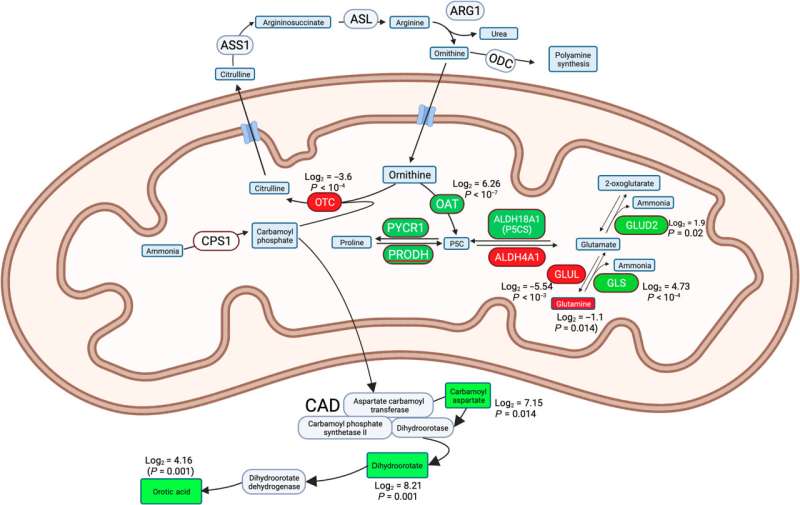This article has been reviewed according to Science X's editorial process and policies. Editors have highlighted the following attributes while ensuring the content's credibility:
fact-checked
peer-reviewed publication
trusted source
proofread
Proteome of rare liver cancer sheds new light on basic biology

Doctors have long puzzled over a mystery at the heart of fibrolamellar carcinoma, a rare and deadly liver cancer that mainly affects children and young adults. Like more common liver cancers, and liver failure itself, fibrolamellar can end in an ammonia spike that leads to coma and death. Curiously, however, the conventional methods for treating ammonia spikes in other liver diseases are somehow rendered ineffective in fibrolamellar.
Now, new research published in Science Advances may explain this mystery, with findings that suggest fibrolamellar's ammonia spike is at least partially coming from the tumor itself. By pinpointing the proteins and metabolites unique to fibrolamellar tumors, scientists have also provided new insight into the basic biology and drug sensitivity of these cancer cells.
"We're seeing a very distinctive change in the proteins of the cancer cells," says Sanford Simon, the Gunter Blobel professor at Rockefeller. "Our observations help explain some of the physiological changes in fibrolamellar, and also some of the pathological changes—including high levels of ammonia, which is a leading cause of death in fibrolamellar carcinoma."
A decade with fibrolamellar carcinoma
Simon began researching fibrolamellar over a decade ago, shortly after his 12-year-old daughter Elana was diagnosed with the rare liver cancer. The Simon lab, in collaboration with Elana, soon discovered a mutation common to many fibrolamellar patients, which was later demonstrated to be a viable drug target for treating the cancer in mice. Simon and colleagues have also led the charge in screening approved compounds for efficacy against fibrolamellar carcinoma.
The disease nonetheless remains essentially untreatable, and often lethal—particularly when ammonia levels begin to spike. "A lot of fibrolamellar patients are dying from high ammonia," Simon says. "They get confused, disoriented, end up in a coma, and often that's the cause of death." Yet time and again, standard treatments for high ammonia fail to work in fibrolamellar.
In an effort to figure out why, Simon and colleagues turned to mass spectrometry to explore the proteomes (the entire complement of proteins) and metabolomes (complement of metabolites) of these enigmatic tumors. They found that many proteins in the cells were quantitatively different from those of healthy tissue or even other liver diseases—with surprising consistency across samples. "These proteomes were so distinctive that we could tell when a sample had been misidentified as fibrolamellar just by looking at protein," Simon says. And strikingly, about half of the protein changes were in the tumor cell mitochondria, a key organelle for handling ammonia clearance and generation.
Wrestling with ammonia
Perhaps the most significant finding was that the signature mutations in fibrolamellar revolved around how the body keeps ammonia levels in check. "All of the top metabolites inside the tumor were related to ammonia metabolism, and they were altered enormously," Simon says.
The fibrolamellar cells also had vastly elevated levels of glutaminase, an enzyme that generates ammonia from glutamine. This suggests that fibrolamellar not only indirectly inhibits the liver's ability to remove ammonia, but also directly adds ammonia to the body—perhaps explaining why removing even part of the fibrolamellar tumor has been shown to reduce ammonia levels.
"Not only is fibrolamellar failing to consume ammonia, it's also generating ammonia," Simon says. "That's a strong argument in favor of taking out some of the tumor, even if you can't take all of it, to reduce the ammonia load—and the chance of an ammonia-induced coma."
That the tumor is producing ammonia would also explain why some liver treatments (which focus on breaking down ammonia in the gut) have fallen flat, while others have shown promise. "A number of patients came out of comas after their physicians switched from treatments that target gut ammonia to treatments that target ammonia throughout the body," Simon says.
The researchers hope their findings may ultimately have an impact on the larger study of cancer biology and ammonia metabolism. It would not be the first time an intent look at a rare cancer bore broadly-applicable fruit. Tumor suppressor genes were initially discovered in rare retinoblastomas; a particular enzyme now implicated in many cancers was first characterized in a rare glioblastoma. The present study's close look at ammonia metabolism through the lens of a rare cancer could open up as-yet unknown pathways for scientific discovery.
"Basic research tells us about the pathology of the disease, but it goes both ways," Simon says. "Disease pathology also teaches us about the basic physiology of the human body, and fibrolamellar may well end up giving us a better understanding of ammonia metabolism itself."
More information: Solomon N. Levin et al, Disruption of proteome by an oncogenic fusion kinase alters metabolism in fibrolamellar hepatocellular carcinoma, Science Advances (2023). DOI: 10.1126/sciadv.adg7038




















